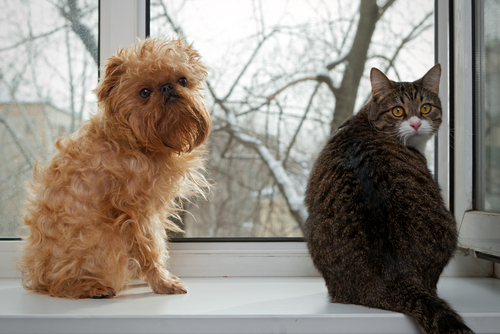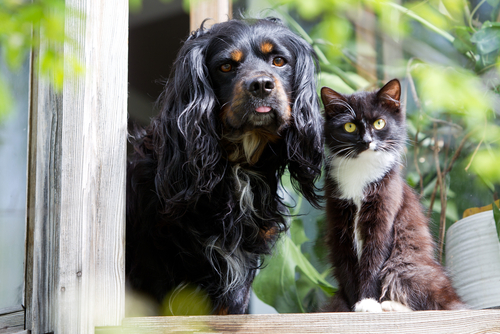“You’re fighting like cats and dogs!”
Have you ever wondered if cats and dogs really can get along?
Contrary to popular opinion, some cats and dogs can be best buddies (at least some of the time), as this video shows:
As a parent to both cats and dogs, I’ve seen my pets have good days and bad days. While we humans have occasionally had to play pet referee, they get along fine the vast majority of the time. If anything, the cats have struggled to get along with each other more than with the dogs.
According to a 2008 study* by Neta-li Feuerstein of Tel Aviv University, that may be because we’ve always had our cats first.
The study, which showed that less than 10 percent of dog-cat relationships involved fighting (considerably better than man-woman relationships), and suggested the best chances for harmony between cats and dogs occurred when the cat was adopted first and the puppy brought in later. The study also indicated the relationship tended to be more amicable if both animals were young when introduced to each other.
Speaking of Dog-Cat and Man-Woman Relationships…
The Tel Aviv University study also explored pets’ abilities to read one another’s body language. The report noted that similar body language can mean very different – in fact, often opposite – things to dogs and cats.
Just like men and women often mean very different things by similar expressions, dogs and cats convey different meanings with similar gestures. An example of this is averting the head – a sign of aggression in felines and of submission in canines. The study suggested that dogs and cats can learn one another’s body language, especially when they’re introduced to each other while young.
OK, But I Got the Dog First… Now What?
Obviously, you don’t want to get rid of your dogs and start over, and thankfully you don’t have to.
Introducing a cat to a dog family is a little tougher than doing it the other way around, but it can be done. Dog trainer Wendi Faircloth has some excellent tips on introducing a cat to your dogs in this video below. While it’s well worth taking the 6:49 to watch, here are the highlights:
- Put the dogs outside long enough for the cat to become acclimated to the house.
- Keep the cat and dogs in separate rooms for the first day to let the dogs get used to the new smell.
- Have your dogs leashed and the cat crated in a large crate when you first introduce them. Faircloth recommends keeping them separated this way when they’re in the same room for a couple days at least.
- Start with your dogs across the room and let them get closer– let the dogs get used to the cat’s presence so they won’t be overly excited when they finally meet face to face.
- Once the dogs are less worked up about the new cat, keep the dogs leashed and let the cat out of the crate. Let the cat approach as she’s comfortable rather than giving the dogs free rein.
- Whatever you do, don’t hold the cat and let the dogs introduce themselves. If the cat panics and starts scratching, it will hurt you and excite the dogs. You can imagine the pandemonium that ensues.
Will it really take that long?
It really depends on your dogs and the new cat. Some dogs are more excitable than others. Some dog breeds’ temperaments are more naturally suited to the changes that introducing a cat brings. However long it takes, though, it’s better to take the time to introduce everyone slowly and let them get used to one another. As with any other relationship, those first interactions set the tone and can affect your cat and dogs’ relationship going forward.
We Already Got Off to a Bad Start…. That’s Why I Googled This in the First Place
So, what can you do if you’ve already done it all wrong? No need to worry. There really isn’t much that isn’t fixable in our pets’ behaviors.
Most dog-cat problems are the result of dogs’ behaviors. That doesn’t mean the dog is being bad, of course, or even aggressive. It does most likely mean that the cat is scared and interpreting the dog’s behavior as aggressive.

So, how do you fix mass-miscommunication between your cats and dogs?
It will take lots of time, lots of effort on the pet parents’ parts, and lots of rewarding the behavior you want to see. Reward your pets’ good behaviors either with attention, healthy treats like TruDog’s premium freeze-dried TREAT ME varieties, or both.
Start by leashing your dog and reintroducing your pets while you have the dog restrained. Make sure that your cat has a way to escape, usually by jumping up off the floor since cats most often feel safer when higher up that the threat. Let the cat feel like she’s in charge of the process. Dogs thrive when they know you’re the alpha. Cats, not so much.
Training your dog how to behave around the cat after the relationship got off on the wrong paw isn’t much different from properly introducing them in the first place, though it may take a little longer, since you now have some bad habits that need to be addressed. Most dogs can learn a new behavior in 10-14 days with patience and consistency on your part.
Using a natural calming aid like CALM ME chews can help with dogs who get overly excited at the prospect of meeting a cat face to face. CALM ME won’t knock your dog out, but it will help reduce anxiety and hyperactivity.
If you have a dog who goes into overdrive around cats and loses sight of everything except the C-A-T, you may need a little help in breaking his concentration before correcting him. A simple training clicker or beeping device is often enough to make your dog stop and look to you for direction.

The most important thing to remember is that the dog is the one you’ll need to control. Cats don’t generally respond well to control; dogs do. Trying to pin down a cat or hold her tightly will most likely result in a panicked cat. If the cat feels like she has control over her environment, she’ll be fine.
**Never leave cats and dogs alone unsupervised until you are sure they aren’t going to hurt each other. **
If your dog feels like you have control over the environment, he’ll be fine. Get both cat and dog used to interacting while you’re in control of the dog and before you know it, your fur-kids will be acting like furry siblings, happy to share the same home.
If you’re thinking about getting pets:
- Get the cat first when possible
- Introduce cat and dog when both are young when possible
If you already have cats and/or dogs:
- Keep control of the dog during interactions for best results
- Reward good interactions between cat and dog with high-level reward treats for both
- If it goes bad, remove the dog to a separate room immediately instead of trying to catch the cat (who will be likely to seek a safe place out of your reach)
- Take it slow, start with introducing your pets to each other’s smells, then graduate to seeing each other through a screen door or window, then progress to same-room interactions
- Remember, it takes time to create new habits for your pets- be patient and consistent
What tips do you have for teaching cats and dogs to get along?
This Post Was Sponsored By The Great Folks At TruDog
Resources:
2008 Study by Tel Aviv University: www.livescience.com/5010-dogs-cats-fine.html
10 Most Cat Friendly Dog Breeds: http://iheartdogs.com/the-10-most-cat-friendly-dog-breeds/
Dogs and Cats Learning to Get Along: https://www.petsit.com/dogs-and-cats-learning-to-get-along
TruDog TREAT ME freeze dried treats for cats and dogs: https://shop.trudog.com/Treats_c_7.html/?utm_source=IHD&utm_medium=blog&utm_content=&utm_campaign=can_cats_and_dogs_get_along
TruDog CALM ME natural calming chews for dogs: https://shop.trudog.com/CALM-ME–Calming-Support-Soft-Chews-60-ct_p_54.html?utm_source=IHD&utm_medium=blog&utm_content=&utm_campaign=can_cats_and_dogs_get_along
//
